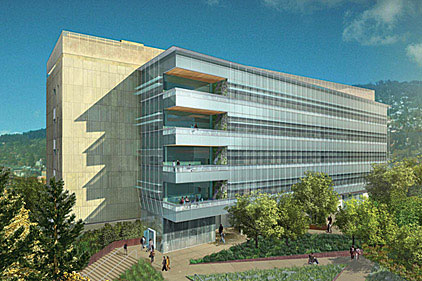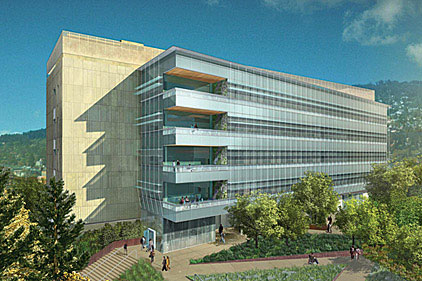 Finding new solutions to the complex challenges of global climate change is the task that drives the scientists and energy industry leaders who collaborate in the Energy Biosciences Institute at UC Berkeley’s new five-story, 11,300-sq-ft Helios Energy Research Facility in downtown Berkeley. UC Berkeley, the University of Illinois and Lawrence Berkeley National Laboratory have partnered with energy company BP, the funding agency, to create the EBI — researching new carbon-neutral biofuels and examining biofuels’ potential environmental, social, and economic impacts.
Finding new solutions to the complex challenges of global climate change is the task that drives the scientists and energy industry leaders who collaborate in the Energy Biosciences Institute at UC Berkeley’s new five-story, 11,300-sq-ft Helios Energy Research Facility in downtown Berkeley. UC Berkeley, the University of Illinois and Lawrence Berkeley National Laboratory have partnered with energy company BP, the funding agency, to create the EBI — researching new carbon-neutral biofuels and examining biofuels’ potential environmental, social, and economic impacts.
The project faced a unique challenge: fit complex, robust MEP systems within the lab’s highly constrained above-ceiling pace — without affecting the budget. With wet labs for molecular and microbial biology, fermentation, and chemical separation, the research facility’s plans demanded fresh thinking from the design/build project team.
Architect SmithGroupJJR and design engineer Gaynor, Inc. faced extremely constrained above-ceiling space. Critchfield Mechanical, Inc. proposed a simplified “single-fix” solution to the space problem: Firespray’s Flamebar BW11 lab exhaust ductwork. The factory-sprayed, welded stainless steel ductwork eliminates the need for a drywall shaft.
“Our project incorporated Flamebar in lieu of using horizontal shaft-wall construction,” said Gabe Pattee, project engineer with Rudoph and Sletten. With the Flamebar BW11 system, the duct is the enclosure. The system reduced the lab exhaust assembly’s footprint more than a foot horizontally and vertically and streamlined construction schedule (fewer inspections required and one-step installation).
In addition, the system met code requirements from the university and state.
“Firespray’s system met the University IOR’s stringent criteria for acceptance and conversion from enclosed ductwork was quick and easy,” said Steve Lopez, vice president, Critchfield Mechanical, Inc. fully compliant with the IMC and UMC and is approved by the State Fire Marshal and by UC for use on Berkeley, San Francisco, and Irvine campuses.
Pattee said the system also saved the university money. “The combination of schedule savings and the elimination of the horizontal shafts proved to be an economically advantageous benefit to the project,” he said.



